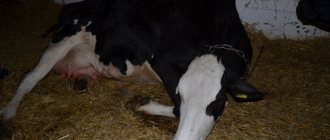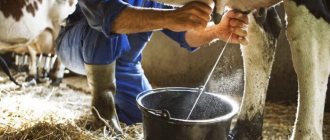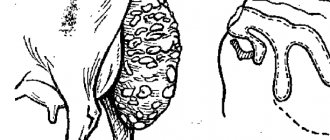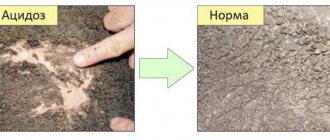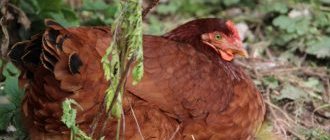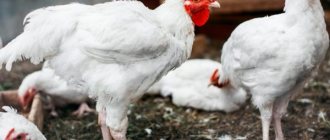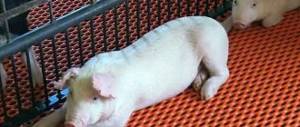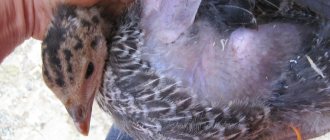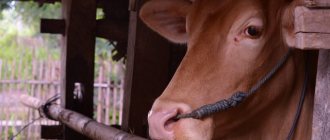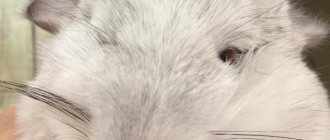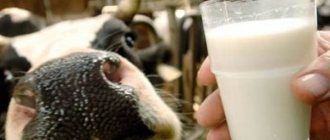0
7190
Article rating
The farm's income depends on the quality of its products. Bloody milk in cows is a common problem; you need to choose the right treatment method. But the disease is easier to prevent, so it is worth taking preventive measures.
():
Leptospirosis is one of the common causes of blood in cows' milk.
Mastitistent/uploads/2018/07/esli-u-korovy-krov-v-moloke2-90×68.jpg 90w" sizes="(max-width: 600px) 100vw, 600px" /> Milk with blood from a cow
():
A low platelet count can cause blood to pass into the milk.
Prevention
they take it often.
High-quality food is introduced into the diet, the amount of juicy food is reduced. They drink 2 times less. The udder is wrapped at night according to the following rules:
- first prepare a solution (1 tbsp. honey, 100 g of vodka);
- then they soak a rag in it and wipe the mammary glands;
- bandaged with woolen material.
Milk the cow every 2-3 hours, then the blood clots will come out faster. Actions must be careful, not causing discomfort to the animal. Ichthyol or camphor ointment is lightly rubbed into the udder. The outflow of blood is ensured by giving the animal a solution of Glauber's salt (400 g per 8 liters of water).
The veterinarian prescribes antibiotics and puts the cow under blockade. These actions will help
Damage to the udder
When the reason for the presence of blood in a cow's milk is a bruise, the plasma will be present for a short time, and not throughout the milking, for example, only at the beginning. The affected quarter may be swollen and blood clots may not pass easily. An important point in this case is the complete milking of all bloody secretions, otherwise the plasma will grow to the inner surface of the quarter and reduce productivity.
To stop the bleeding, you can use drugs for intravenous administration, for example calcium chloride in a ten percent solution. For mild bleeding, you can use a folk remedy, for the preparation of which you will need:
- nettle leaves;
- yarrow;
- shepherd's purse.
Take 100 g of a mixture of these herbs and pour 2 liters of boiling water, boil for 2 minutes. The decoction is given to the animal several times a day for a week. After about seven days, you can begin to gently massage the udder with light movements.
Udder bruise
spread of bacteria to other parts of the udder. The following treatment regimen is often used:
- 10 ml of 20% caffeine under the skin (if you need to support cardiac activity);
- 200 ml 40% glucose intravenously;
- 200 ml of 10% calcium chloride intravenously;
- 8 ml of penicillin intramuscularly after 4-5 hours.
Medicines are prescribed for 3 days. In this case, the calf is transferred to artificial nutrition. Untreated mastitis will lead to complete cessation of milk production and hardening of the udder.
Causes
Blood in cow's milk is an alarming symptom. It may indicate udder pathologies:
- Development of mastitis.
- Problems with blood vessels.
- Injury to the udder or one part of it.
- Mechanical damage to the nipples.
To understand what is happening to the cow, it is necessary to consider each of the problems in detail.
Mastitis
Cows often experience mastitis, an inflammation of one or more lobes of the udder. Brown cows are especially susceptible to this disease after calving, when their immunity decreases. There are different types of mastitis, but almost all of them have the same symptoms:
- The udder enlarges and becomes hot.
- On palpation, a compaction is felt.
- The animal's milk yield decreases.
- Lost appetite.
- The cow is lethargic.
- Often milk, after expressing and standing in the cold, changes consistency.
Note. There is also a hidden form of mastitis, which is diagnosed only with the help of a milk sample and special tests.
There are many reasons for the development of inflammation in the udder:
- Nipple injury.
- Poor living conditions - damp, cold room.
- Infectious diseases of other organs, such as the uterus.
- Decreased animal immunity.
- Inadequate diet.
Blood in milk
Blood in milk can occur with advanced forms of mastitis. If a farmer notices a decrease in milk yield, loss of appetite and lethargy in his cow, he needs to contact a veterinarian.
Vascular disorders
Blood in the milk of cows may indicate weakness of the vascular walls. This happens when an animal's diet lacks certain vitamins. If after milking the milkmaid notices that the milk has turned pink, but the animal has no other symptoms of deterioration in well-being, there is no reason to panic. It is possible that during exposure to the udder with a device or with your hands, a vessel burst, causing blood to ooze out. You should observe the cow for 2-3 days. In most cases, this situation does not repeat itself. However, it is worth consulting a veterinarian on how to strengthen the animal’s blood vessels. Typically, animals are prescribed:
- Vitamin C.
- Vitamin K
- Calcium.
- Hemostatic agents.
Reference. It is necessary to monitor the cow’s diet so that she receives all the beneficial substances and microelements, then her blood vessels will become stronger.
Bruises
Cows sometimes injure each other in the pasture
In the pasture, cows sometimes injure each other - they butt and kick. In this case, the udder may be damaged, resulting in the formation of an internal hematoma, which is not always visible to the naked eye. In some cases, compaction and enlargement of the affected lobe are detected. Touching the udder is painful.
Attention! With bruises of the mammary gland, blood in the milk is most often found in the form of clots.
If a cow has bloody clots in her milk, but her condition seems normal, it is likely that we are talking about a hematoma in the udder. The animal needs to be provided with rest for several days. On the first day, a cooling compress should be applied to the site of the bruise, and on the next day - vodka. For better resorption of the hematoma, a light massage of the affected lobe and the application of an iodine mesh are recommended.
Reference. The accumulation of blood in the breast tissue can lead to mastitis.
Damage to the udder
If the milk tank is damaged, blood is also found in the milk. How an animal can get hurt:
- While walking. Animals cling with their udders to sharp objects - branches, stones.
- During milking with the machine.
- In case of inaccurate manual milking.
Cracks in the nipples are another reason for the appearance of bloody inclusions in the milk of a cow. They are formed due to improper care of the milk tank. Before starting milking and after it is finished, you need to rinse the teats with warm water and inspect them for microcracks. They often form due to dry skin. Over time, the affected tissues swell and the damage becomes deeper. The farmer should be alert to the animal's restless behavior during milking and when touching the nipples.
Attention! The appearance of microcracks in the nipples is associated with the risk of infection and the development of mastitis.
Cracks
Wipe it with a damp cloth or wash it with warm water, then wipe it;
If damage is detected, the nipples are treated using iodine, hydrogen peroxide or Rivanol. Then apply more Vaseline to soften it.
Prevention of mastitis in cows
How to properly treat mammary glands with mastitis?
You should give milk every couple of hours to help the blood clots come out faster. In this case, you need to rub camphor oil or ichthyol ointment with massage movements. To make the blood come out faster, the animal is given water with Glauber's salt to drink in a ratio of 400:8000.
During therapy, it is necessary to wrap the mammary glands. First, they are washed or wiped with a damp, warm cloth soaked in a solution of a tablespoon of honey and 100 g of alcohol, after which they are wrapped in a woolen scarf and tied up. It is advisable to make a compress at night.
To prevent inflammation from spreading to even larger areas of the udder, the animal is given a blockade and given antibiotics. All procedures are performed by a veterinarian. Therapy should only take place under the supervision of a specialized doctor.
Cracks
The reason for the appearance is dry skin of the nipples due to loss of elasticity and softness. This happens as a result of poor care. Microcracks increase if the problem is not identified in time.
Symptoms of damage are as follows:
- nipple swelling;
- restless behavior of the animal, especially during milking (due to severe pain);
- the appearance of bloody impurities in milk.
The cow does not allow the cow to approach the udder, which contributes to the development of the inflammatory process. To prevent complications, it is worth regularly examining the mammary glands of cows. If cracks are detected after milking, the teats are treated with a 2% soda solution. Then lubricate with ichthyol ointment. You can relieve the cow's pain using ointment with novocaine (applied before the process).
To prevent the formation of cracks, regularly wash the udder, dry it with a towel, lubricate it with moisturizer, or prepare the following mixture:
- 200 g of vegetable oil are mixed with 3 tbsp. l. melted paraffin;
- placed in a water bath;
- stir until smooth.
When contaminants get into damaged areas, warts form, which are removed through surgery. Even with the development of bacteria, there is a risk of mastitis.
():
Several infections, including those caused by bacteria (Leptospira spp, Brevibacterium erythrogenes, Serratia marcescens, Micrococcus cerasinus, Micrococcus chromidrogenes rubber, Micrococcus roseus, Lactorubefaciens gruber, Sarcina rubra, etc.), viruses and red yeast (Monascus purpureus), can cause intravascular hemolysis and damage to capillaries in the udder, which leads to the appearance of a reddish tint in the milk.
Cow udder inflammation
The answer to the question why a cow's milk is bloody may be an inflammatory disease. A reddened, hot udder with dense lesions characterizes the onset of mastitis. Almost immediately after the calves appear, the cow notices red sediment in her milk. The most common sources are:
- germs from unwashed floors;
- infection in open wounds;
- inflammation of the uterus;
- poor quality nutrition;
- rough unprofessional milking.
More on the topic: Characteristics of Voronezh cow breeds
The cow produces milk mixed with blood due to the course of the pathological process in one or all lobes of the udder. Blood has been added, which means this is already a severe form of inflammation. If treatment is not organized, the milk may disappear completely. In case of illness, antibiotics and lotions are used while the animal is resting.
Vascular dysfunction
Blood appears in milk when a vessel bursts. This happens due to a lack of certain vitamins during milking, regardless of the method (by machine or by hand). The milk product takes on a dark pink color. In this case there are no clots. Usually the problem is eliminated without permission, but it is worth helping the cow by providing it with the following medications:
- ascorbic acid;
- hemostatic agents;
- calcium and potassium.
Vitamins will strengthen blood vessels, and the problem will not appear again in the future. It is also worth giving animals food containing essential microelements. You should also consult a doctor to rule out more serious illnesses.
():
Sometimes the reddish color of milk can be associated with eating feed containing plants belonging to the Rubiaceae family.
[dzs_videogallery]
Why is there blood in cow's milk?
Blood in milk, in any case, is a rupture of the udder vessels. It is caused by mechanical reasons:
- Strong tension of blood vessels with subsequent rupture when it is impossible to compensate for the stretching. This often happens with improper manual or machine milking.
- A rupture of blood vessels can also be caused by an injury to the udder - a cut, puncture, bruise, bite, etc.
- When there is an excess of milk, when the vessels simply cannot cope with the pressure of rapidly arriving milk (during the period of milking).
- During mastitis, swelling of the alveoli causes a traumatic rupture of blood vessels and, as a result, blood appears in the milk.
Depending on the cause of blood in milk, a different period is required for treatment and restoration of the udder.
Cracks in the udder
Cracked nipples can be caused by poor care, which reduces the softness and elasticity of the skin. The skin on the nipples dries out very quickly and small cracks appear. If you do not pay attention to this in time, the nipple may swell, the cracks will increase, which will lead to bloody discharge and severe pain.
During milking, the animal becomes very nervous and does not allow access to the udder, which can lead to severe inflammation. To prevent the formation of cracks, the cow should be carefully looked after. You need to wash your nipples regularly and do this with warm water, then wipe them with a dry and clean towel.
If, nevertheless, you have identified microcracks on the nipples, then you should immediately begin treatment. To do this, after milking, you need to treat the teats with a 2% soda solution diluted in warm water, then lubricate them with ichthyol. If the cow feels severe pain when touched, then before milking you can lubricate the nipples with an ointment containing novocaine.
How to prevent the occurrence of mastitis?
Any injuries to the udder, including bruises, often cause the development of mastitis. Prevention of this disease requires constant attention. What do we have to do:
Udder care - prevention of mastitis
- Carefully care for the mammary gland and nipples of the cow - wash with warm water, wipe with a clean cloth.
- Keep the animal in good conditions - warm, on soft bedding, avoid drafts.
- Provide the cow with high-quality nutrition, which will have a beneficial effect on its immunity.
- To prevent the development of stagnant processes in the udder - milk the cow regularly, express the entire volume of milk.
- Regularly inspect the mammary gland for minor damage and lumps.
- Monitor any changes in the consistency and color of the milk.
- Treat the gland for prevention.
What is mastitis in a cow?
One of the most common diseases in dairy farming is mastitis. Appears against the background of some complications after childbirth, which are supplemented by problematic care and feeding. Disorders affect the udder at the level of glandular tissue.
General symptoms are presented:
- health problems;
- decreased productivity levels;
- elevated temperature;
- the appearance of foreign clots in the product;
- pain and anxiety during manual milking.
Did you know? Cows have a well-developed sense of time: for example, a milkmaid being half an hour late reduces milk yield by 5% and the fat content of the product by 0.4%.
